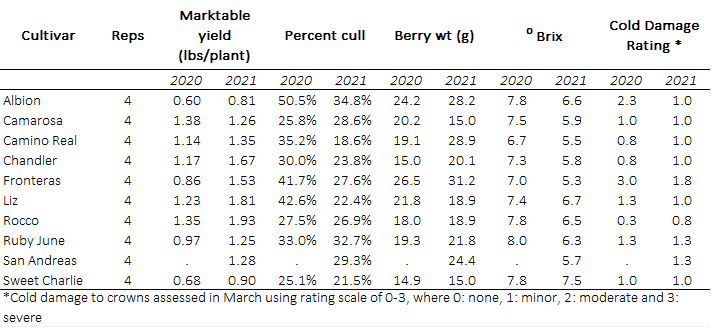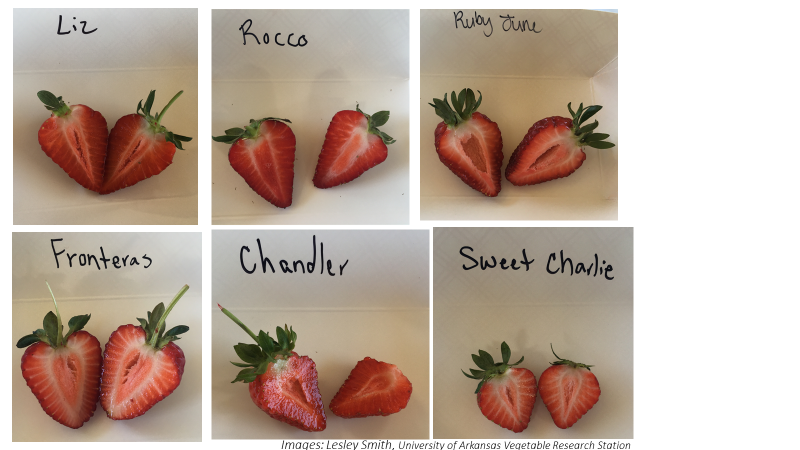Dr. Amanda McWhirt, Horticulture Specialist, University of Arkansas
We have conducted strawberry variety evaluations over the last two years to compare ten strawberry cultivars for yield, and fruit quality measures in Arkansas. Trials were conducted at the University of Arkansas Vegetable Research Station near Ft. Smith (zone 7b). In both years plug plants were planted in late September into plasticulture beds and managed using standard fertility and fungicide programs recommended for the Southeast. Row covers (1 oz) were used for freeze and frost protection as needed.
During both seasons there were significant cold events that resulted in cold injury to strawberry crowns and blooms. Most notably in November of 2019 there was an early freeze event (temps near 20°F) prior to the plants hardening off that resulted in severe cold injury to the crowns of young plants and in February 2021 artic air (0 to -10°F) during crop dormancy also injured strawberry crowns. As a result we also rated the strawberry varieties for cold injury to crowns.
See a previous article to learn more about our assessments of cold injury to strawberry crowns and see pictures: https://smallfruits.org/2020/10/impact-of-fall-cold-injury-to-strawberry-crowns-on-spring-yield/?cat=26
Strawberry yields were lower in 2020 compared to the 2021 season (Table 1). Low yields in 2020 are likely related to the more severe cold injury observed following the November 2019 freeze event. Very high rates of cull in 2020 were related to rain injury and animal damage. Rain damage in 2021 continued to be a contributing factor to cull rates, but animal damage was greatly reduced.
Our results indicate that the NCSU strawberry breeding program releases ‘Rocco’ and ‘Liz’ are both well adapted to be grown in Arkansas. ‘Rocco’ produced early season fruit similar to ‘Sweet Charlie’ but had larger fruit size, a longer fruiting season and higher yields. The lowest incidence of cold injury to crowns was observed for ‘Rocco’ in both years.
In both years ‘Liz’ was among the highest yielding cultivars that we tested and was comparable in season to ‘Camarosa’. During the 2021 season ‘Liz’ had higher rates of cull than in the 2021 season but had cull rates fairly similar to ‘Camino Real’ in 2021.
‘Fronteras’ consistently produced the largest fruits size but had the highest incidences of cold injury in both years, and this injury likely resulted in reduced fruit yields.
The day-neutral type ‘Albion’ performed relatively poorly with low yield and high rates of cull fruit during both seasons. In 2021 another day-neutral type ‘San Andreas’ was trialed and had higher yields and lower cull rates than ‘Albion’.
Informal taste tests were conducted with station staff and in 2020 and ‘Ruby June’ was a favorite. In that year ‘Ruby June’ had the highest level of fruit brix of the cultivars we tested. Additionally, ‘Camino Real’, ‘Fronteras’, ‘Liz’ and ‘Rocco’ were rated favorably for flavor in that season.
We thank the Mid-American Strawberry Growers Association for their support of these trials. Also, we want to acknowledge the University of Arkansas Vegetable Research Station staff for their tremendous support of this research.
Table 1. Marketable yield, cull rates, average berry weight, fruit soluble solids (Brix) and cold damage ratings for ten strawberry cultivars planted at the University of Arkansas Vegetable Research Station (zone 7b) during the 2020 and 2021 spring harvest season.

Figure 1: Strawberry fruit cut in-half during 2021 season. Images from Lesley Smith, University of Arkansas Vegetable Research Station.
